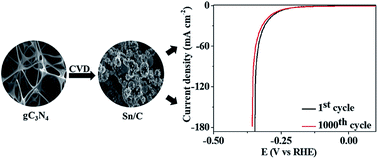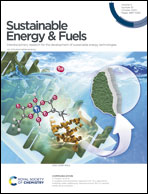In situ fabrication of dendritic tin-based carbon nanostructures for hydrogen evolution reaction†
Abstract
In this work, dendritic tin-based carbon (Sn/C) nanostructures with four different morphologies were synthesized by a facile two-step carbonization and chemical vapor deposition method and were then evaluated for their performance in hydrogen evolution reaction. The Sn/C dendrites are approximately 0.5–4.5 μm in length, each having secondary branches in different directions. The four morphologies of the Sn/C dendrites namely nanoflowers (Sn_NCF1), nanospheres (Sn_NCF2), nanocubes (Sn_NCF3) and nanocuboids (Sn_NCF4), behave differently in their electrochemical performance, with Sn_NCF2 and Sn_NCF1 performing better. Sn_NCF2 demonstrates optimal HER performance compared to other Sn based samples with onset potential and overpotential of 100 and 260 mV, respectively. The higher electrochemical surface area observed in Sn_NCF2 originated from the presence of more catalytic sites which contributed to the enhanced HER activity and better current density, against other Sn-based samples. In addition to the improved HER performance, Sn_NCF2 demonstrates excellent stability with less than 6% degradation of its initial current after operating for over 8 h in acidic media.



 Please wait while we load your content...
Please wait while we load your content...